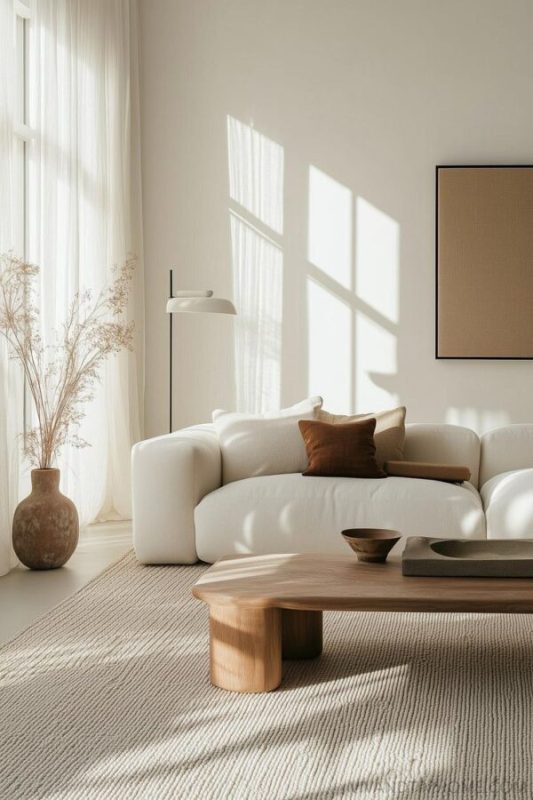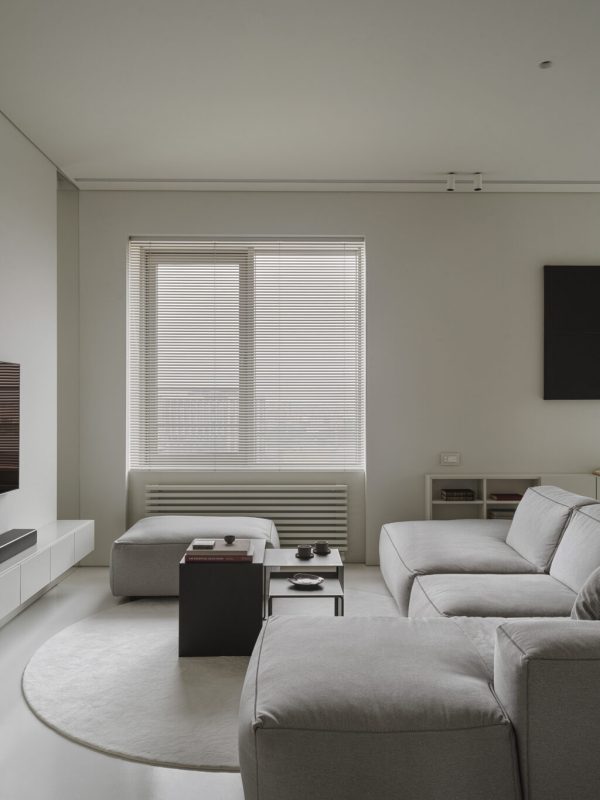Micro-Living Luxury: Small Space Design That Feels Expansive

Small spaces aren’t limitations , they’re invitations. Invitations to design smarter, live lighter, and create homes that feel deeply intentional. Today’s micro-living movement isn’t about squeezing into tight quarters; it’s about discovering luxury in clarity, comfort, and creative possibility. From clever multifunctional layouts to materials that amplify light and mood, modern small-space design has become a study in effortless elegance. Less square footage doesn’t mean less beauty , it simply means every inch contributes to a life that feels curated, calm, and surprisingly expansive. Here are 19 thoughtful, human-centered ideas to help any compact home feel open, elevated, and undeniably luxurious.
1. Designing with Light Neutrals

Light neutrals create instant visual spaciousness. Soft whites, oat milk, pale beige, and cool greige open up the room while giving it a luxe, hotel-like feel. These tones reflect light gently, removing visual heaviness and creating an atmosphere that feels fresh. Layering neutrals, linen curtains, boucle seating, stone accents, adds subtle dimension without clutter. In micro-living, light palettes act like a quiet foundation, letting every surface feel airy and expansive.
2. Furniture That Opens Up Space

Low-profile furniture helps small rooms breathe. Sofas with shorter backs, platform beds, or sleek armchairs create long sightlines, making ceilings appear higher. This proportion shift feels inherently modern and sophisticated. By lowering the visual center of gravity, the entire space feels more open. Pair low seating with taller accents, plants, lamps, artwork, to create balance. Together, they produce a luxurious sense of scale, even in tight quarters.
3. Windows as Your Biggest Asset

Windows are the most valuable feature in any small home, and treating them intentionally can make the entire space feel bigger. Keep window treatments light,think linen sheers, ceiling-mounted rods, or minimal blinds,to let daylight flow freely. Avoid bulky curtains or dark fabrics that visually “cut off” the room. Arrange furniture to frame the window rather than block it, allowing the eye to travel outward. When windows are unobstructed, the boundaries between inside and outside blur, creating a luxurious sense of openness far beyond the actual square footage.
4. Corners with Purpose

Unused corners can become miniature sanctuaries that add both beauty and function. A single accent chair can create a reading nook; a floating shelf can form a micro-workspace; a small round table can transform an empty corner into a quiet coffee spot. Using corners wisely prevents the room’s center from feeling overcrowded. Corners also soften the layout visually, helping the space feel balanced and thoughtfully designed. In small homes, these understated micro-zones elevate daily living and maximize every inch.
5. The Luxury of a Murphy Bed

A Murphy bed is one of the smartest, and most luxurious, space solutions for small apartments. Unlike sofa beds, Murphy beds allow you to keep a full, comfortable mattress without sacrificing floor space during the day. When closed, the panel can function as shelving, a desk, or artwork. When open, it becomes a cozy nighttime refuge. Murphy beds create visual harmony by keeping the room open when not in use, instantly making your living area feel twice as spacious.
6. Built-Ins That Transform Nooks

If your home has an architectural niche,a recessed wall, alcove, or awkward pocket,turn it into built-in storage or seating. Built into the wall, these additions look intentional rather than improvised. A shallow niche can become a bookshelf; a deeper one can house a bench, bar cabinet, or desk. Because built-ins sit flush with the wall, they create a clean, streamlined look that expands the room visually. Luxury in small spaces often comes from this kind of tailored, architectural precision.
7. The Power of White Paint

White paint is a classic small-space strategy for a reason, it expands light, erases shadows, and makes walls recede. But not all whites are equal. Soft whites with warm undertones feel inviting and luxurious, while crisp whites make the space feel modern and airy. Use white to open up narrow hallways, brighten dark corners, and create flow between rooms. It provides a clean backdrop that lets materials, fabrics, and greenery stand out without overwhelming the space.
8. Zones That Bring Order

Creating zones is essential in micro-living. Instead of thinking in terms of “rooms,” think in terms of “areas.” A rug can mark a living zone; a pendant light can define a dining corner; a tiny table beside a window can become a workspace. Zoning gives structure without walls, helping the home feel organized and intentional. When each area has a purpose and flow, the space feels larger, not because of square footage, but because of clarity and good rhythm.
9. A Dining Table Sized for Real Life

Downsizing your dining table doesn’t mean giving up elegance,it means choosing a function that matches your lifestyle. Round tables save space and soften the layout. Drop-leaf tables expand only when needed. Slim rectangular tables work beautifully against a wall when not in use. Choose pieces with refined finishes, light wood, marble, textured stone, to keep the look luxurious. When your dining area feels proportional, the entire room opens up.
10. A Clearer, Calmer Home

Clutter steals space faster than walls do. Keeping surfaces clear and limiting visible objects enhances openness and calm. Use trays to gather small items, baskets to hide necessities, and concealed storage to maintain order. A clutter-free home feels larger not because it physically is, but because the eye can move without interruption. Luxury in small spaces often begins with simplicity, a kind of visual quiet that makes the home feel airy and thoughtful.
11. Plain Upholstery for Cleaner Lines

In small homes, busy patterns or bold prints can make furniture feel bulky. Plain upholstery, linen, cotton, textured neutrals, keeps the room visually calm and unified. This doesn’t mean dull; it means refined. You can bring interest through cushions, throws, or accent pieces. Smooth upholstery helps furniture blend into the architectural space instead of competing with it, creating an elevated, serene atmosphere that feels luxurious rather than overwhelming.
12. Use Mirrors Intentionally for Illusion and Light

Mirrors are interior design’s oldest magic trick, and in small spaces, they’re practically necessary. A large mirror across from a window doubles the light instantly, making the room glow. Floor-length mirrors add height, while mirror-paneled furniture adds glamour and reflection without overwhelming. Using reflective surfaces strategically creates the feeling of depth, like your home has hidden dimensions. The trick is not to overuse them; one dramatic mirror often does more than four smaller ones.
13. Make the Most of Natural Light

Natural light is one of the most powerful tools for expanding a small space. Keep windows as open as possible by choosing sheer curtains, slim blinds, or ceiling-mounted rods that let light flow freely from top to bottom. Avoid placing tall furniture directly in front of windows, and use reflective surfaces—like light-colored walls, mirrors, or glass décor—to bounce daylight deeper into the room. The brighter the space, the larger and more luxurious it feels. In micro-living, maximizing sunlight instantly transforms compact rooms into airy, uplifting retreats.
14. Furniture with Rounded Edges

Rounded furniture instantly softens a small space and improves the sense of flow. Curved sofas, oval coffee tables, and circular ottomans eliminate sharp corners that visually block movement or feel heavy in compact rooms. These gentle contours make the layout feel more fluid and inviting, while also creating a subtle sense of luxury. Rounded silhouettes are easier on the eye, giving the room a more open, effortless look. They also encourage better circulation within the space, allowing you to move naturally without navigating around harsh edges. In micro-living, curves add elegance and comfort in equal measure.
15. Paint The Ceiling

Painting the ceiling is one of the simplest yet most transformative ways to make a small space feel larger. A light-colored ceiling, soft white, warm cream, or pale greige, reflects natural and artificial light, drawing the eye upward and creating the impression of higher walls. For added sophistication, choose a shade slightly lighter than the walls to create gentle contrast without breaking the flow. This technique visually “opens” the room from above, making compact spaces feel airy, calm, and architecturally lifted without any structural changes.
16. Extend Storage Vertically

Tall shelving is one of the most powerful tools for expanding a small space. By building upward instead of outward, you free up valuable floor area while dramatically increasing storage. Floor-to-ceiling shelves draw the eye upward, making ceilings feel higher and the room more spacious. Vertical shelving also doubles as a design feature,styling books, plants, baskets, and decor creates a curated, intentional atmosphere. Whether built-in or freestanding, tall shelves turn empty wall space into functional storage that elevates the aesthetic.
17. Go Big With Art or Rugs

In small spaces, larger pieces often create a more expansive feel than many small items competing for attention. A single oversized artwork draws the eye upward and simplifies the wall, making the room look taller and more cohesive. Likewise, a generously sized rug anchors the layout and visually widens the floor, helping the furniture feel connected rather than scattered. These bold, scaled-up choices add drama, polish, and clarity, turning compact rooms into thoughtful, gallery-like spaces. Going big reduces clutter and amplifies the sense of luxury in micro-living environments.
18. Create a Tonal Look

A tonal color palette is one of the most effective ways to make a small space feel cohesive and expansive. Instead of mixing many contrasting shades, choose one base color, like beige, greige, oatmilk, or soft taupe, and layer lighter and darker variations of that hue throughout the room. This creates a smooth visual flow with no abrupt breaks, allowing the eye to travel easily from wall to furniture to décor. Tonal styling feels elevated, modern, and calming, giving even compact rooms a refined sense of unity and quiet luxury.
19. Wall-Mount Your TV

Wall-mounting the TV is one of the simplest ways to free up valuable floor and surface space in a small room. Instead of using a bulky media console, mounting the screen keeps the layout open and prevents the TV from becoming an oversized focal point. It also allows you to use the space underneath for seating, shelves, or décor, giving the room a lighter and more luxurious feel. Pair the TV with a slim mount or frame-style model so it sits close to the wall and blends seamlessly into the overall design. This small change can make the entire room feel more expansive.
Wrap Up
Micro-living doesn’t mean sacrificing comfort, when designed thoughtfully, small spaces can feel open, elegant, and deeply personal. Luxury in compact homes comes from intention: smart storage, light-filled layouts, and furniture that keeps the room breathing. With the right choices, even the smallest apartment can feel expansive and uplifting. At Home Designing, we celebrate the beauty of living well in every square foot, offering ideas that bring clarity, warmth, and modern style to real homes. Because true luxury isn’t about size, it’s about how a space makes you feel.






